
VOICE Home Page: http://www.os2voice.org
[Previous Page] [Next Page]
[Features Index]
 VOICE Home Page: http://www.os2voice.org |
[Previous Page] [Next Page] [Features Index] |
|
Reviewed by Mark Dodel ©June 2000 IBM Product Information: http://www.networking.ibm.com/wireles/wdprods/jb.htm |
This wasn't the most important goal in my life, so I didn't want to spend a huge
amount of time and money on it. This is a want not a need. But I started to look
around for possibilities. Most wireless products were either wireless modems or
wireless LAN kits for windoze. Neither was of any use to me. If you are looking
for wireless modem access to the internet for non-windoze systems, check out Tim
Sipples article Going
Wireless without Windows http://www.32bitsonline.com/article.php3?file=issues/199911/Timmynovdec&page=1
where he discusses a number of possibilities.
I guess Tim is the expert in this field, since the only other reference I have
found in regard to this is an AskTimmy letter response also in 32BitsOnline magazine
http://www.32bitsonline.com/article.php3?file=issues/200003/timmy-mar-00&page=1
where he talks about wireless LAN options that may work with OS/2. He mentions Aironet
http://www.aironet.com
which may have some OS/2 drivers, but I couldn't find mention of OS/2 at their
site, but at least one product - their 340 series does list NDIS2 support in their
driver download. Aironet has recently been absorbed by Cisco. Their products are
not cheap, even the stuff listed as for home use. I wasn't looking to spend several
hundred dollars for this project. Tim's other suggestion was the IBM Wireless LAN
products. I decided to take a look on the net for any wireless solutions.
The seller fatkat@foxberry.net had 100
units of the IBM Wireless LAN on auction and no bidders. Starting price was $79
for the whole kit of the two ISA/MCA cards and 1 PCMCIA card. Looking at the IBM
overview of the product showed that it been withdrawn effective April 21, 1997,
but it looked like really nice commercial grade hardware. According to the overview,
it could support up to 50 users, up to a clear path distance of 1600 feet/500 meters.
It used the same 2.4GHz Spread Spectrum Frequency Hopping that the newer units I
see today for several hundred dollars each. Bandwidth is only 500Kbps-1.2Mbps, but
I don't plan on running a server with it, just internet access, and that is better
then a standard dialup. So I put a bid on it and since there was no competition
I won the bid for the minimum price. Tack on $15 for shipping, I received the whole
kit for $94. That was well within my budget. No problem to me that there are no
windoze 9X drivers. :-) The kit does support the following networking environments:
IBM LANServer, IBM LAN Program, Novell NetWare, Novell Personal NetWare, Microsoft
LAN Manager, Microsoft Windows NT, Microsoft Windows for Workgroups, Banyan VINES,
and Artisoft LANtastic. Drivers are included for OS/2(2.1 and Warp), Microsoft Windows
3.1 with DOS (5.0 or higher) and Novell NetWare (3.11 or higher). System requirements
are minimal - 386 or higher processor and 4MB RAM.
Systems used for installing this product are the following:
Laptop Workstation: Toshiba Satellite 2545XCDT with AMD K6-2 333MHz, 64Meg EDO RAM, 4.1 Gig HD, 2 Type II PCMCIA sockets, 24X CDROM, built in Lucent win-modem. Running OS/2 Warp 4 with Fixpack 10.
Base Server: Toshiba Equium 6200M with Dual Pentium Pro 200Mhz, 132 Meg EDO RAM, built-in Adaptec AIC7870 SCSI controller, Quantum Viking II 9.1 Gig HD, Seagate Cheetah 9.1 Gig HD. Mylex Flashpoint LW UW SCSI controller, Yamaha CRW4416SX CDRW drive and HP 5P Scanjet. Network cards: Linksys DFE-530TX 10/100 and built-in Intel Pro 100B. Running OS/2 Warp Server for eBusiness.
Alternate base machine: Sag SuperMicro P6DNF with Dual Pentium Pro 233Mhz, 132 Meg EDO RAM, Adaptec AHA2940-UW SCSI controller, IBM 9.1 UW-SCSI HD, 32X SCSI CDROM. Network card: Kingston Etherfast 10/100. Running Warp Server eBusiness.
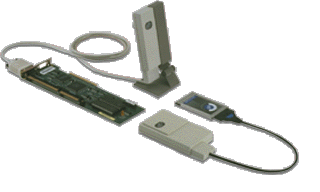
Of all the diskettes that were in the box, there were only 4 of the 6 diskette
set in English. Of course the 2 missing diskettes were for the OS/2 drivers. Not
a major problem though as the current driver disk images are available online at
http://www.networking.ibm.com/wirenew/downloads.html#lan.
Before downloading these I tried the Japanese diskettes. The display was in Japanese
(like that was a surprise), so I gave up and downloaded the IBM disk files and created
diskettes.
One thing I did pick up from the manual was that I need to set up a base unit
first and then a workstation. Also that I needed to run the self-booting diagnostic/configuration
Utility diskette to verify that settings of the hardware in each machine.
The PCMCIA card has no switches on it and is completely configured using the
DOS configuration disk as well as the Network Driver. The ISA/MCA card has a bank
of DIP switches on it. You use these to set an I/O Base Address, RPL Memory Enabled/Disabled,
an IRQ(which has to be exclusive, not shared by any other device), and an ISA DMA
level. The ISA/MCA cards are dual-bus, which means the cards can be used in either
a Industry Standard Adapter slot or a IBM Micro-Channel Adapter slot, depending
on which side of the card you insert into the slot.
I left the I/O Base set at it's default, the RPL Memory set at Disabled, and
verified that an IRQ was available on the machine I was installing it into and set
left the DMA at the default of 0.
After attaching the radio transmission unit (a 4.5x2.5x.75 inch plastic covered
box) to the end of the supplied 1.5 meter cable and plugging that into the installed
ISA card I then powered on the machine. They include several one-side adhesive plastic
velcro-like patches to attach the radio transmission unit to an elevated location.
There is also an optional 4 meter cable kit as well as a Custom Cable kit that can
be purchased separately. Before booting to OS/2 I went into my system BIOS and set
the IRQ I had chosen (11 in this case) to ISA Legacy. Every system BIOS is different,
some allow you to specifically set an IRQ as in use by an ISA device so that it
isn't assigned to any PCI devices. Some allow you to set a specific IRQ to a specific
PCI slot. Some don't allow you to do anything, in which case you have to pray the
system works out any conflicts.
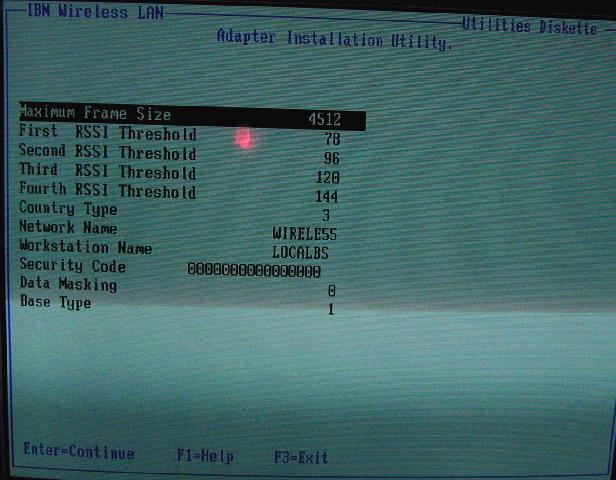
You have to set up a Network Name for use by all devices on this wireless cell.
I choose WIRELE55 only because the last 2 characters have to be numeric and '55'
looks a lot like 'SS' so I could have my first choice for a Network Name which was
'WIRELESS'. You have to choose a Workstation Name unique to each device on the cell.
Initially I set the Country Types for all cards to 1 for the United States/Canada.
These cards support several different country types, each with varied signal strength
and allowed frequencies. Other selections include ETSI(European Telecommunications
Standard Institute), Japan, New Zealand, Mexico, France (hey aren't they in Europe?),
Hong-Kong, Australia and Korea. So as not to make initial setup even more confusing
I left the Security Code and Data Masking at defaults which is off. It is nice to
know that this setup has the capability to encrypt the radio transmissions between
workstations and base. Finally there is Base Type, which can be set to 1 for Ethernet
or 2 for Other. The Adapter Installation Utility has some basic help which briefly
explains the basic parameters.
Once booted into OS/2 I installed the OS/2 Base driver software which takes up
about 2.5 Meg of space and creates an "IBM Wireless Services" folder on
your desktop. The folder contains a readme file, "IBM Wireless LAN" object
and "Base/NAP Station Configuration" object. So as not to be fancy I used
the Basic Base/NAP configuration screen to configure the Base. I choose Not Bridged
for Wireless Connectivity. This was confusing to me at first since my goal was to
connect the wireless LAN to my hardwired LAN which is in turn connected to the Internet
via a cable modem. But reading up on it seemed to imply that the "Bridged to"
selection was only to be used for a few specific hardwired IBM Network cards, none
of which I had.
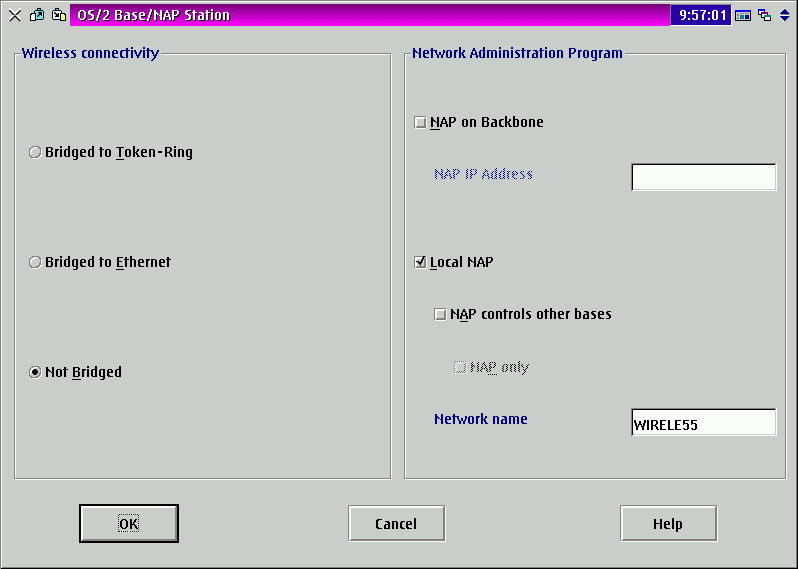
After completing this I started MPTS (Also known as "Network Adapters and
Protocol Services" in your OS/2 System Setup folder). Select Configure, then
Configure again. There should now be an "IBM Wireless LAN Network Adapter for
base station" under the Current Configuration. Only protocol listed will probably
be IBM IEEE 802.2. Since I want to have both Internet and File and Print networking
I added IBM TCP/IP and IBM OS/2 NETBIOS. You also have to edit the drivers parameters,
by double-clicking on the IBM WIreless LAN Network Adapter entry listed under Current
Configuration. There are 6 parameters: Bridge activation, which is set to NO. Buffers
size which defaults to 256 and can range from 256 to 2048 in 8 digit increments.
LAN type, which can be E for Ethernet or T for Token Ring. Locally Administered
Address which is the installed cards MAC address and is optional. Interrupt Level
which is the IRQ of the installed card. And last parameter field is I/O base address
which one would think is the I/O base address assigned to the card by the DIP switches
on it. There appears to be no connection between the two, and the manual mentions
both but not if or how they are related. Range for this last field can be 200 to
900 but the hardware values set by the DIP switches are HEX numbers between 86A0
and F6A0. I tried many different values, but I don't think it made any difference.
Basically like the IRQ, the I/O base address can't be in use by any other device
in your system, otherwise there will be a conflict.
Next I then started the TCP/IP configuration setting notebook and enabled LAN1
as LAN0 was already enabled for my hardwired LAN. I assigned 192.168.1.1 as the
IP address for this TCP/IP interface. My intention being to have two subnets for
TCP/IP. My main hardwired LAN having 192.168.0.* and the wireless LAN having 192.168.1.*
IP addresses. At that point I rebooted to establish the networking changes.
I then started the "IBM Wireless LAN" object that was created in the
IBM Wireless Services folder. That starts the IBM Wireless LAN Supervisor program
which in turn starts the Network Administration Program(NAP).
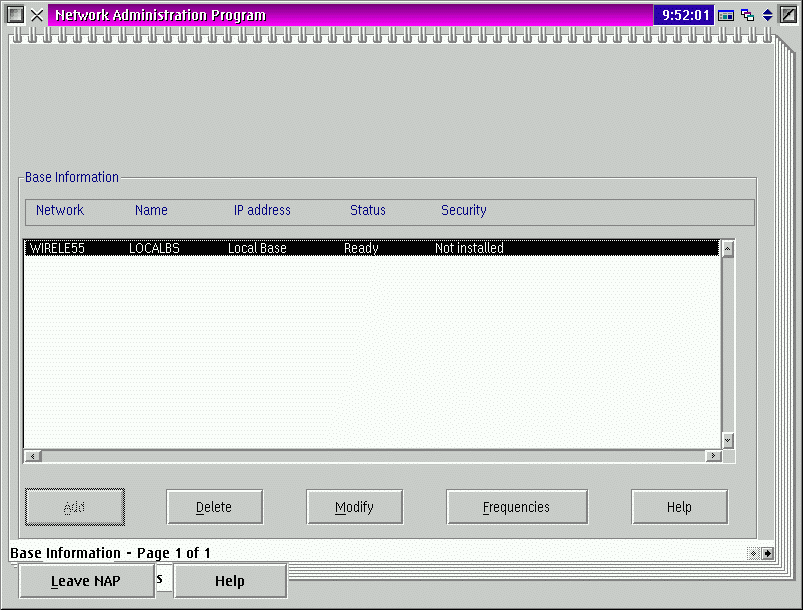
If the base is setup correctly, you should see it listed under Base Information
and it should have a status of Ready . There is no way to test that the base
is actually transmitting/receiving. You have to setup a workstation to connect to
the base. This makes the next step tougher for the first time you setup a workstation(and
in my case I only have one workstation). If you encounter workstation problems,
is it really the workstation or could it be that the base isn't working right.
I then installed the PCMCIA card into my laptop, and configured it using the
same DOS based self-booting Utility diskette. The PCMCIA card uses 1 Type II slot.
I connected the foot long antenna cable to the PCMCIA card and then to the transceiver
unit. I then attached the transceiver unit to the back of the laptops screen using
the included adhesive squares.
As part of the utilities there is a diagnostic function and a Received Radio
Signal Strength test function. I was unable to get the Radio Strength test to find
the base unit at all. I tried messing with a number of things including the Base
Type parameter, the DIP switches on the ISA card. Nothing I could do would register
any radio connection from the base. Finally in desperation I changed the Country
Type on both cards to 3 for Japan, and the thing started to work. Who'd of thunk
it? It appears that even though you can set the Japanese units as Country Type 1(US/Canada),
it won't actually work, but you can set the US market units as a 3 (Japan) and that
works. I suppose the Japanese transceivers are throttled back to only work with
power settings and frequencies for Japan, which is a subset of the US/Canada model.
The only clue I had that these might be Japanese market cards, was the fact that
2 sets of manuals/diskettes arrived in Japanese. Heaven forbid IBM actually clearly
mark the hardware as being for a particular market. I later found out that you can
tell which country code the hardware is for by looking at the last 2 digits of the
serial number on the radio transceiver unit. Two of mine had "03" for
Japan and the third had "01" for US/Canada.
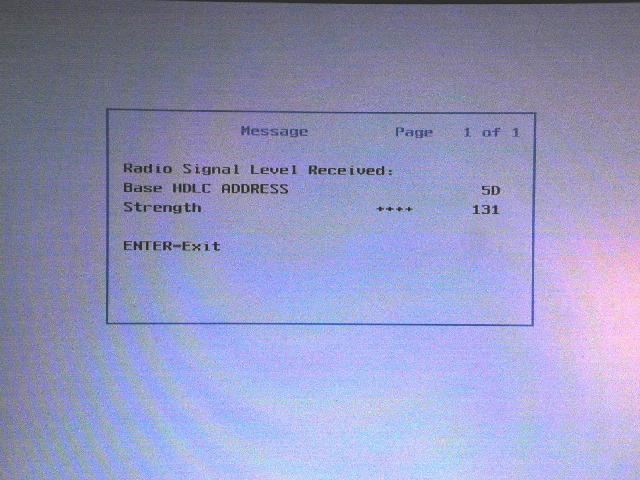
After finally verifying that the PCMCIA unit was communicating with the OS/2
base, I then installed the OS/2 Workstation NDIS software on the laptop. I gave
the workstation the name WIREL2. You have to get the MAC address of the workstation(s),
to add to the base configuration Access list. You can get this either from the Utility
Diagnostic program or by running the "Get UAA" object in the workstation's
IBM Wireless Services folder that is created when you install the workstation software.
![]() Here the Radio Signal Strength
Indicator on my Laptop shows 4 "+".
The more green, the better the higher the level of the signal. Signal strength varies
from a high of 4 to 5 "+"
with my laptop in my office with-in a couple feet of the base unit to 2 to 3 "+" with the laptop outside on my patio table, which
is roughly 50 feet through several rooms and a wood/vinyl siding exterior wall.
You should now see the workstation listed on the Base unit's NAP Security Workstation
List. Also re-aligning the direction of the laptop can make a big difference in
the signal strength.
Here the Radio Signal Strength
Indicator on my Laptop shows 4 "+".
The more green, the better the higher the level of the signal. Signal strength varies
from a high of 4 to 5 "+"
with my laptop in my office with-in a couple feet of the base unit to 2 to 3 "+" with the laptop outside on my patio table, which
is roughly 50 feet through several rooms and a wood/vinyl siding exterior wall.
You should now see the workstation listed on the Base unit's NAP Security Workstation
List. Also re-aligning the direction of the laptop can make a big difference in
the signal strength.
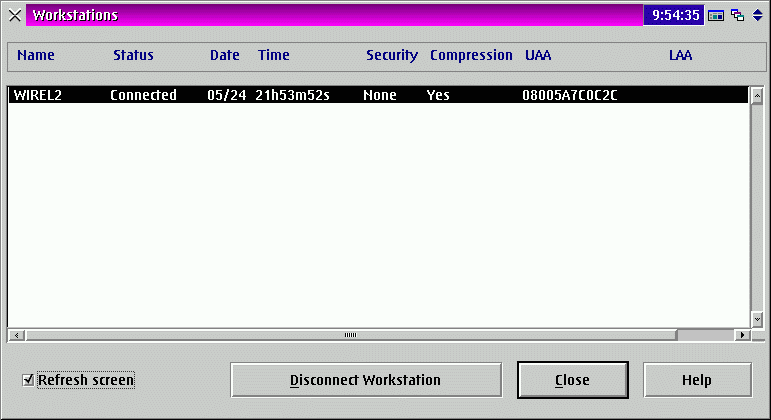
I opened MPTS (AKA: Network Adapters and Protocol Services in the System
Setup folder) and added the IBM TCP/IP protocol to the IBM Wireless LAN
Network Adapter for base station Network Adapter on the Base and then to the
IBM Wireless LAN Network Adapter for workstation Network Adapter on the laptop.
Next I added an internal ip address for each using the TCP/IP Configuration object
on each machine. My idea was to create a separate subnet from my hardwired LAN as
follows:
|
| |||
|
Server: |
192.168.0.5 |
WSeb |
TCP/IP 4.2.1 |
|
workstation1: |
192.168.0.1 |
WSeb |
TCP/IP 4.2.1 |
|
workstation2: |
192.168.0.2 |
W4FP13 |
TCP/IP 4.02y |
|
laptop: |
192.168.0.6 |
W4FP10 |
TCP/IP 4.2.1 |
|
| |||
|
laptop: |
192.168.1.6 |
W4FP10 |
TCP/IP 4.2.1 |
|
workstation1: |
192.168.1.1 |
WSeb |
TCP/IP 4.2.1 |
|
Server: |
192.168.1.5 |
WSeb |
TCP/IP 4.2.1 |
Finally in desperation I listened to a suggestion from Duane Chamblee of Indelible
Blue WarpUp fame. He suggested
I remove the hardwired LAN adapter on the laptop and only have a Default Route to
the Wireless NIC (Network Interface Card). Bingo, all of a sudden I had internet
access on the laptop via the wireless. If anyone has an idea of how to have the
two coexist in the same workstation please let me know, but for now I can only have
one or the other in the laptop. In the base station I have no problem with having
the wireless NIC installed along with a hardwired NIC and even a third network card
for connecting to my cable modem in my server machine. Finally I was free of the
wire noose.
In my office I get a Max thruput of 59.12 Kb/s on ipmonitor. Not super speed,
but more then adequate for surfing the web, downloading mail, reading news and chatting
on IRC. PINGing the www.os2voice.org site from my laptop in my office shows a minimum
of 100ms, average 168ms, maximum 260ms. PINGing www.os2voice.org from the server
base shows a minimum of 70ms, average 87 and maximum 150ms.
There is a Java applet at http://142.165.159.250/andvaag/andvaag-classes/TestTCPApplet2.html
which claims the ability to test TCP/IP performance. I tried it on both my hardwired
LAN workstation and my wireless LAN laptop. Both are running "JDK 1.1.8 IBM
build o118-20000323" and both route to the internet via a COM21 DOCSIS cable
modem attached to my server running Injoy Gateway. I have no idea on the accuracy
of this test, but it gives a relative speed comparison.
|
Hardwired workstation which is running TCP/IP 4.02 |
Download test result |
475,648 bytes read in 10,102 millseconds |
376,676 bits/second |
|
Upload test result |
204,800 bytes written in 10,032 millseconds |
163,317 bits/second | |
|
Wireless laptop, which is running the TCP/IP from WSeB (4.2.1) |
Download test result |
310,404 bytes read in 10,023 millseconds |
247,753 bits/second |
|
Upload test result |
270,336 bytes written in 10,265 millseconds |
210,685 bits/second |
Next I restarted MPTS and added IBM OS/2 NETBIOS protocol to the wireless
LAN adapter on both the base (which was now my server) and my laptop workstation.
Setting up File and Print Networking was easy at this point, especially since I
already had it working on this laptop via the hardwired LAN. I use Warp Server eBusiness
as a server for my little LAN, so no peer configuration was required. I created
a batch file to add to my STARTUP Folder to initiate the LAN connections. From then
on as long as I could communicate with the base unit, I could access my server's
LAN resources.
The other problem that had me pulling my hair out was the TCP/IP routing with
two NICs (Network Interface Cards) in the workstation. Even disabling the hardwired
interface and setting the Default ROUTE for the wireless NIC wouldn't get me access
to the internet via my alternate or main server. So if you can explain how I can
do that please drop me a line. I actually don't miss my old IBM Home and Away 10MBPS
PCMCIA Network card. It may have been faster then the wireless NIC, but the wireless
NIC is more then sufficient for general web surfing, Usenet, email and IRC.
I can now use my laptop outside or anywhere in my home. The manual states that
objects made of wood, glass, brick or plastic are relatively transparent to the
radio signal. Water absorbs a lot of the signal, so I guess I can't take it in the
pool, and metal is highly reflective, so if you are in a metal cubicle environment
this may not work at all.
What is really cool about this product is that you can have multiple bases spread
around, and the workstation will automatically switch to a new base station if it
loses connection with it's current base. With that feature you can extend the range
significantly. Most likely newer wireless products from other vendors can do the
same and many seem to provide higher bandwidth, but is the cost worth it and will
these other products support OS/2?
Though the install was frustrating in how to tell what was wrong, now that I
figured it all out, I'm very satisfied with this hardware. It was a bargain for
less then $100.
If you are coming to Warpstock 2000 in
Philly in September, stop by the VOICE booth. I plan on bringing my backup server
base and my wireless laptop workstation. Of course since it is wireless I may be
wandering about attending all the sessions I missed last year, since I don't have
that leash anymore.
